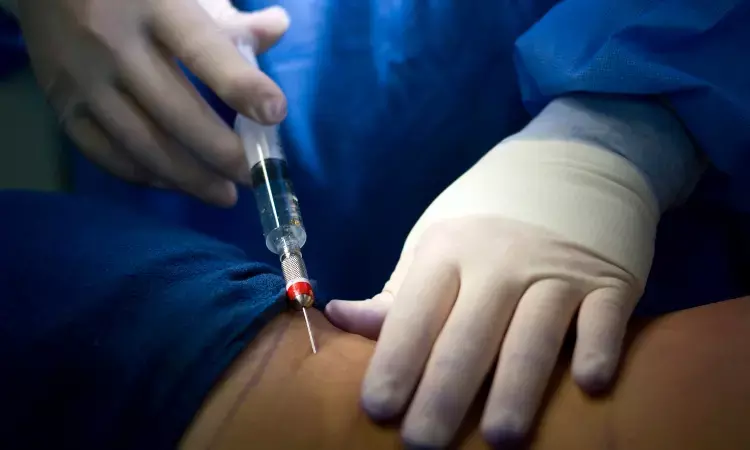- Home
- Medical news & Guidelines
- Anesthesiology
- Cardiology and CTVS
- Critical Care
- Dentistry
- Dermatology
- Diabetes and Endocrinology
- ENT
- Gastroenterology
- Medicine
- Nephrology
- Neurology
- Obstretics-Gynaecology
- Oncology
- Ophthalmology
- Orthopaedics
- Pediatrics-Neonatology
- Psychiatry
- Pulmonology
- Radiology
- Surgery
- Urology
- Laboratory Medicine
- Diet
- Nursing
- Paramedical
- Physiotherapy
- Health news
- Fact Check
- Bone Health Fact Check
- Brain Health Fact Check
- Cancer Related Fact Check
- Child Care Fact Check
- Dental and oral health fact check
- Diabetes and metabolic health fact check
- Diet and Nutrition Fact Check
- Eye and ENT Care Fact Check
- Fitness fact check
- Gut health fact check
- Heart health fact check
- Kidney health fact check
- Medical education fact check
- Men's health fact check
- Respiratory fact check
- Skin and hair care fact check
- Vaccine and Immunization fact check
- Women's health fact check
- AYUSH
- State News
- Andaman and Nicobar Islands
- Andhra Pradesh
- Arunachal Pradesh
- Assam
- Bihar
- Chandigarh
- Chattisgarh
- Dadra and Nagar Haveli
- Daman and Diu
- Delhi
- Goa
- Gujarat
- Haryana
- Himachal Pradesh
- Jammu & Kashmir
- Jharkhand
- Karnataka
- Kerala
- Ladakh
- Lakshadweep
- Madhya Pradesh
- Maharashtra
- Manipur
- Meghalaya
- Mizoram
- Nagaland
- Odisha
- Puducherry
- Punjab
- Rajasthan
- Sikkim
- Tamil Nadu
- Telangana
- Tripura
- Uttar Pradesh
- Uttrakhand
- West Bengal
- Medical Education
- Industry
Perfusion Index may Predict for SAIH in Orthopedic Surgery, Less Effective in Elderly: Study

A new study published in the journal of BMC Surgery showed that Perfusion Index (PI) is a non-invasive tool for predicting spinal anesthesia-induced hypotension in lower extremity orthopedic surgery patients (cut-off value = 2.25), but shows reduced accuracy in elderly individuals.
The most frequent side effect of spinal anesthetic is hypotension, which is becoming more widespread and potentially harmful in elderly people. Thus, this study was set to examine how the PI predicts spinal anesthesia-induced hypotension (SAIH) during lower extremity orthopedic surgery, as well as how age affects this prediction.
This research was performed on 120 elective patients aged 18 and older who were in the ASA I-II-III risk categories and were receiving supine lower extremities surgery while under spinal anesthesia. Every patient's demographics, baseline hemodynamic parameters, and PI values were evaluated and documented.
Patients were split into two groups as non-elderly (group NE, under 65) and elderly (group E, over 65). Before spinal anesthetic began, a 400 mL maximum saline infusion was started. For spinal anesthesia, 10–12.5 mg 0.5% hyperbaric bupivacaine was administered to each subject, and the block's dermatomal distribution was recorded. Hemodynamic factors, PI readings, and any possible problems were tracked during the procedure.
There were 101 patients in the final analysis. Both groups' demographics were comparable, with the exception of age, ASA, and operation type. A multivariable logistic regression analysis was performed to further assess the PI's independent predictive value for SAIH, controlling for surgical variables, age, BMI, comorbidities, and ASA score.
Higher ASA values were linked to increased risk (p = 0.024), according to the research, which found that ASA score was a strong predictor of hypotension. Interestingly, it was discovered that the preoperative PI was a significant independent predictor of hypotension (p = 0.020).
In all patients, but particularly in group NE, a high baseline PI was directly associated with SAIH (AUROC = 0.675 (0.568–0.781), p = 0.002; AUROC = 0.727 (0.579–0.875), p = 0.006).
SAIH was not predicted by baseline PI in group E (AUROC = 0.579 (0.417–0.740), p = 0.336). In group NE, the PI cut-off was 1.75 (68% sensitivity, 64% specificity), whereas in all patients, a cut-off of 2.25 indicated SAIH with 65% sensitivity and specificity.
Hemodynamic and PI data at various time points did not significantly differ between groups (p > 0.05). When compared to group E, group NE utilized more fluids and bupivacaine (p = 0.013 and 0.014, respectively). Above the cut-off levels, both groups had higher rates of ephedrine usage and hypotension (p > 0.05).
Overall, for patients having orthopedic lower extremity surgery, PI is regarded as a non-invasive technique that may be used to predict SAIH (cut-off value = 2.25). The senior patient group, however, did not show the same efficacy.
Reference:
Kavak Akelma, F., Mafizer, M., & Nalbant, B. (2025). Perfusion index as a predictor of hypotension after spinal anesthesia in lower extremity orthopedic surgery: a prospective observational trial. BMC Surgery, 25(1), 348. https://doi.org/10.1186/s12893-025-03036-y
Neuroscience Masters graduate
Jacinthlyn Sylvia, a Neuroscience Master's graduate from Chennai has worked extensively in deciphering the neurobiology of cognition and motor control in aging. She also has spread-out exposure to Neurosurgery from her Bachelor’s. She is currently involved in active Neuro-Oncology research. She is an upcoming neuroscientist with a fiery passion for writing. Her news cover at Medical Dialogues feature recent discoveries and updates from the healthcare and biomedical research fields. She can be reached at editorial@medicaldialogues.in
Dr Kamal Kant Kohli-MBBS, DTCD- a chest specialist with more than 30 years of practice and a flair for writing clinical articles, Dr Kamal Kant Kohli joined Medical Dialogues as a Chief Editor of Medical News. Besides writing articles, as an editor, he proofreads and verifies all the medical content published on Medical Dialogues including those coming from journals, studies,medical conferences,guidelines etc. Email: drkohli@medicaldialogues.in. Contact no. 011-43720751


